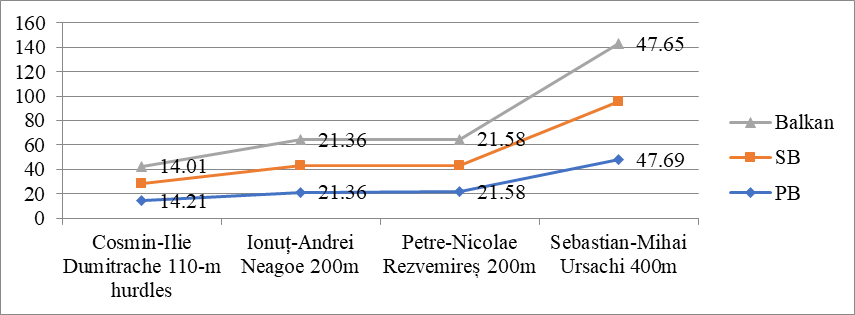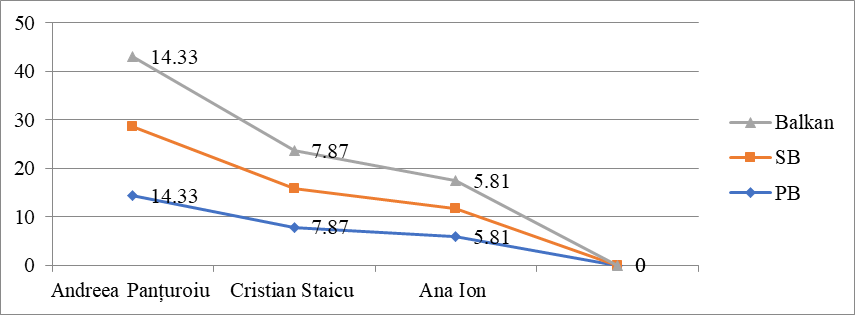Abstract
Our article starts from the premise that the external environment and the public (through its quality, quantity and involvement) contribute to the creation of a favourable microclimate for the manifestation and increase of the athletes’ performance potential by activating their intrinsic and extrinsic motivational levels during the competition. In this way, the development and implementation of a strategy to promote the Balkan Senior Athletics Championships, edition 2016, Pitesti – Romania, as a component of sports marketing were evaluated and analysed on several planes, one of them being the value of the performances of the Romanian athletes from the perspective of their own records and of the best performances of that year. The results of the research show that the presence of the audience, the number of spectators, the crowd’s attitude towards athletes, the encouragement from the public, the evolution towards the family, friends and knowledge contributed to the achievement of personal or seasonal records for most Romanian athletes (in some of the tests, 50%, respectively 100% of them achieved the best performance at this contest). Our research was based on the questionnaire survey, with working tools developed and validated by us. Finally, the results obtained were those that have entitled us to conclude that the promotion of this competition has positive effects on the results achieved and the development of athletics.
Keywords: PromotionBalkan Championshipseffectsathletics
Introduction
Athletics infrastructure in Pitesti allows specific training to be carried out in very good conditions; the sports centre has been approved by the IAAF since 2014, which facilitated the organization of national and international athletic competitions after 20 years, thus enabling the plenary performance of athletes. Starting in 2014, by constructing the two tracks (one for competition and the other for practice, both approved by the IAAF), Pitesti has returned to the map of Romanian athletics, from the point of view of organizing competitions: the Balkan Senior Athletics Championships (three consecutive years, 2014, 2015 and 2016), the Balkan Junior Championships, the International Championships of Romania, the National Championships and the University Championships took place so far. From the research conducted by us (Niţă & Mihăilescu, 2017a, 2017b) with respect to all principles, requirements and objectives of marketing in general (Kotler, 1986; Cutlipp, Center, & Broom, 1994; Pop, 1998; Balaure, 2002; Schwarz & Hunter, 2008) and sports marketing in particular (Florescu et al., 1992; Mihăilescu, 2008; Stoica, 2011; Voicu & Nagel, 2003), a strategy to promote Balkan Athletic Championships was prepared. The main methods, means and materials used for the marketing strategy were: television communication, local press and online press, press conference, social media (Facebook), interviews with athletes participating in the competition, posters and flyers.
Problem Statement
Unfortunately, in the previous competitions, the audience was small, and this was also reflected in the results. We have seen that promotion through the local media determines the creation of a suitable environment for capitalising/maximising the athletes’ performance potential in competition by attracting a large, well-informed and active audience.
Research Questions
How much can the media contribute to attracting the public by promoting the competition? How can the results of the competition be improved?
Purpose of the Study
Our research was a complex one and, within it, we aimed to increase the performance level of athletics both locally and nationally by promoting in the media the international competitions of the participating Romanian athletes.
Research Methods
The marketing strategy focused on promoting the participating athletes, their results, the importance of the competition – the 75th edition, the posters and flyers produced and distributed for the event, the news and programs made before the beginning of the Balkan Athletics and during it on a Facebook page. To evaluate the results of our strategy, we then used the observation, the questionnaire survey method. The questionnaire developed for assessing the emotional, motivational, awareness- and accountability-related impact of the international competition in Romania was had a mixed structure, consisted of 28 items and was distributed to 50 athletes.
Findings
From the athletes’ responses to the items of the questionnaire applied before the competition, we have found that:
-
all athletes appreciated the methods and means of promoting the competition, stating that they had seen the promotion of the local media commission on various channels of communication;
-
60% of the surveyed athletes stated that they were the source of media coverage of the competition;
-
over 70% of athletes believe that media promotion can improve their results in the contest.
The results of the Romanian team at this edition of the Balkan Senior Athletics Competition determined the 2nd place overall and the 1st place in women’s category.
From the analysis of the results recorded in the two days of the competition, we have found that:
in the 110 metres hurdles, 100% of the Romanian athletes exceeded their season record, setting a personal record;
in the 200 metres, 100% of the Romanian athletes exceeded the season record, setting a personal record;
in the 400 metres, 50% of the Romanian athletes exceeded their season record, setting a personal record;
for women’s triple jump, 100% of the Romanian athletes exceeded their season record, establishing a personal record;
for men’s long jump, 100% of the participating Romanian athletes exceeded the season record, establishing a personal record;
for women’s long jump, 100% of the participating Romanian athletes exceeded their season record, establishing a personal record;
in the javelin throw, 100% of the Romanian athletes increased the season record, setting a personal record;
in the shot put, 50% of the Romanian athletes exceeded their season record, setting a personal record.
The Balkan Athletics ranking and the athletes who improved their results in the sprinting, jumping and throwing events are shown in Table


![Athletes who improved their results – Throwing events]](https://www.europeanproceedings.com/files/data/article/108/4513/ICPESK2018F088.fig.003.jpg)
Conclusion
Positive changes have also been reported in clubs around the city: at CSM Pitesti, for example, a year after the competition, there was a 30% increase in the number of athletes certified. Another positive change is that FC Arges, a club governed by the Pitesti Administration, has set up the Athletics Section, which now has very good results, relying on the double membership of the top athletes from CSM Pitesti. In addition, 100% of the surveyed people said that they would bring their children or grandchildren to practice this sport in the next period, being fascinated by how the athletes looked, how they behaved and how athletics has developed them. A further 100% of respondents would like Pitesti to host such competitions in the future. In order to evaluate the effects of the media strategy for promoting the Balkan Athletics Championship, the 75th edition, Pitesti, 2016, on the development of athletics, we analysed the results obtained by the Romanian Team in this competition. Thus, we were interested in finding out how the athletes felt the impact of the media strategy of attracting the public to the competition on the improvement of their results. We also recorded the spectators’ opinions on the development of future athletic games in the local area.
References
- Balaure, V. (2002). Marketing (Ed. a II-a revăzută şi adăugită). Bucureşti: Uranus.
- Cutlipp, S. M., Center, A. H., & Broom, G. M. (1994). Effective Public Relations. Englewood Cliffs, NJ: Prentice-Hall, Inc.
- Florescu, C., Balaure, V., Boboc, Șt., Cătoiu, L., Olteanu, V., & Pop, N. Al. (1992). Marketing. Bucureşti: Marketer.
- Kotler, Ph. (1986). Principles of Marketing (3rd ed.). Englewood Cliffs, NJ: Prentice Hall, Inc.
- Mihăilescu, N. (2008). Organizare şi conducere în structurile sportului. Pitești: Editura Universităţii din Pitești.
- Niţă, G., & Mihăilescu, L. (2017a). Contributions to identifying the sport marketing relationship - the media in the promotion of the international athletics. In The Annual International Conference “Physical Education, Sport and Health”, 23-24 November 2017 (pp. 218-225). Pitești, Romania.
- Niţă, G., & Mihăilescu, L. (2017b). Research on the organizational environment involved in the promotion of international athletic competitions. In The Annual International Conference “Physical Education, Sport and Health”, 23-24 November 2017. Pitești, Romania.
- Pop, N. Al. (1998). Marketing. Bucureşti: Editura Didactică şi Pedagogică.
- Schwarz, E., & Hunter, J. (2008). Advanced theory and practice in sport marketing. Oxford: Butterworth-Heinemann.
- Stoica, F. (2011). Contribuția mass-media în marketingul sportiv. Pitești: Tiparg.
- Voicu, S., & Nagel, A. (2003). Managementul sportului. Timişoara: Editura Universităţii de Vest.
Copyright information

This work is licensed under a Creative Commons Attribution-NonCommercial-NoDerivatives 4.0 International License.
About this article
Publication Date
16 February 2019
Article Doi
eBook ISBN
978-1-80296-054-9
Publisher
Future Academy
Volume
55
Print ISBN (optional)
-
Edition Number
1st Edition
Pages
1-752
Subjects
Sports, sport science, physical education
Cite this article as:
Niţă, G., & Mihăilescu, L. (2019). Promotion Of Balkan Championships – Effects On Athletics Development. In V. Grigore, M. Stănescu, M. Stoicescu, & L. Popescu (Eds.), Education and Sports Science in the 21st Century, vol 55. European Proceedings of Social and Behavioural Sciences (pp. 717-721). Future Academy. https://doi.org/10.15405/epsbs.2019.02.88
